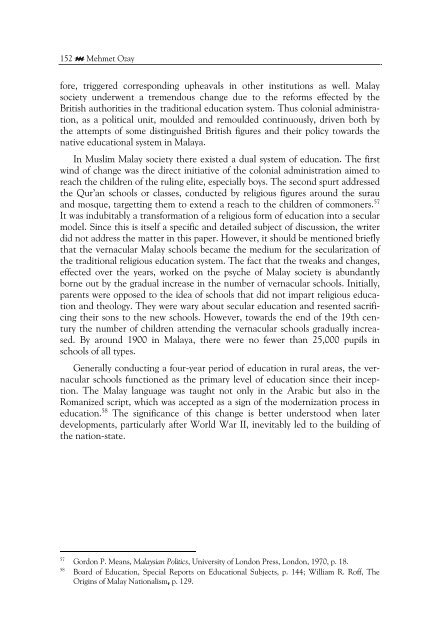İçindekiler - İlahiyat Fakültesi - Marmara Üniversitesi
İçindekiler - İlahiyat Fakültesi - Marmara Üniversitesi
İçindekiler - İlahiyat Fakültesi - Marmara Üniversitesi
Create successful ePaper yourself
Turn your PDF publications into a flip-book with our unique Google optimized e-Paper software.
152 Mehmet Ozay<br />
fore, triggered corresponding upheavals in other institutions as well. Malay<br />
society underwent a tremendous change due to the reforms effected by the<br />
British authorities in the traditional education system. Thus colonial administration,<br />
as a political unit, moulded and remoulded continuously, driven both by<br />
the attempts of some distinguished British figures and their policy towards the<br />
native educational system in Malaya.<br />
In Muslim Malay society there existed a dual system of education. The first<br />
wind of change was the direct initiative of the colonial administration aimed to<br />
reach the children of the ruling elite, especially boys. The second spurt addressed<br />
the Qur’an schools or classes, conducted by religious figures around the surau<br />
and mosque, targetting them to extend a reach to the children of commoners. 57<br />
It was indubitably a transformation of a religious form of education into a secular<br />
model. Since this is itself a specific and detailed subject of discussion, the writer<br />
did not address the matter in this paper. However, it should be mentioned briefly<br />
that the vernacular Malay schools became the medium for the secularization of<br />
the traditional religious education system. The fact that the tweaks and changes,<br />
effected over the years, worked on the psyche of Malay society is abundantly<br />
borne out by the gradual increase in the number of vernacular schools. Initially,<br />
parents were opposed to the idea of schools that did not impart religious education<br />
and theology. They were wary about secular education and resented sacrificing<br />
their sons to the new schools. However, towards the end of the 19th century<br />
the number of children attending the vernacular schools gradually increased.<br />
By around 1900 in Malaya, there were no fewer than 25,000 pupils in<br />
schools of all types.<br />
Generally conducting a four-year period of education in rural areas, the vernacular<br />
schools functioned as the primary level of education since their inception.<br />
The Malay language was taught not only in the Arabic but also in the<br />
Romanized script, which was accepted as a sign of the modernization process in<br />
education. 58 The significance of this change is better understood when later<br />
developments, particularly after World War II, inevitably led to the building of<br />
the nation-state.<br />
57<br />
Gordon P. Means, Malaysian Politics, University of London Press, London, 1970, p. 18.<br />
58<br />
Board of Education, Special Reports on Educational Subjects, p. 144; William R. Roff, The<br />
Origins of Malay Nationalism, p. 129.



